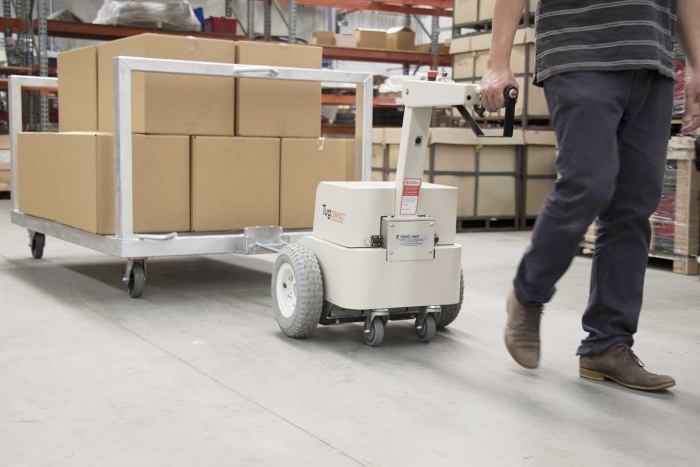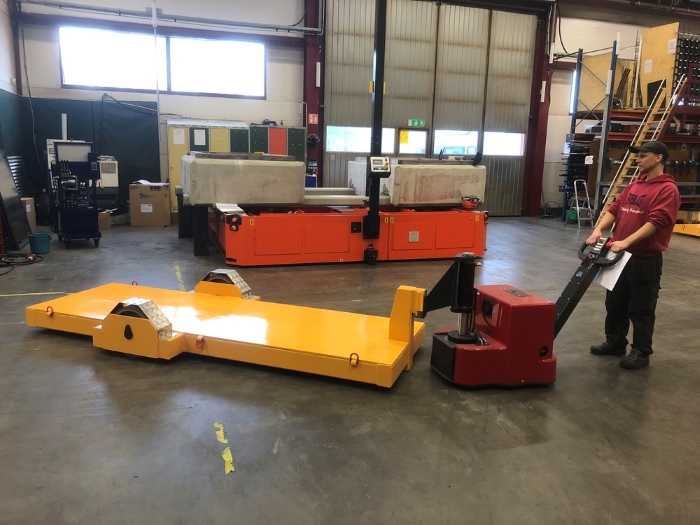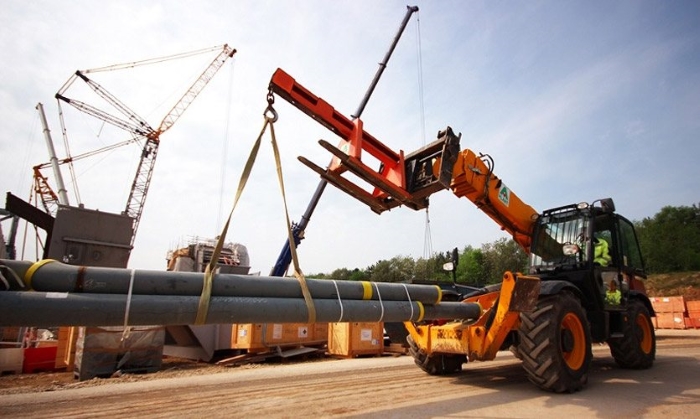It’s fascinating just how much of a contrast there is between the massive exteriors of some factories, warehouses, and wholesale outlets, and how little space there is in their interiors to move around. Fixed machine locations, and static staging and storage configurations often mean that unoccupied floor space in many of these facilities comes at a premium. The operation of heavy material handling equipment, such as forklifts and riding pallet trucks, isn’t always wanted or even possible.
Be that as it may, parts and materials still need to be transported quickly from point to point throughout the various working phases, though. And they need to be moved in a manner that doesn’t sacrifice occupational health or safety. In short, if you’re in charge of material handling activities at one of these locations, it means you’re always looking for ways to work smarter, not harder … and yes, safer too.

Smart handling solutions
Smart material handling practices ensure goods are moved in such a manner that they don’t present an unnecessary risk of employee injury due to pushing or pulling, as well as minimize the number of employees that need to be exposed to that risk. In environments where trolleys, bins, and roll cages are constantly being moved across shop floors, over ramps, and in and out of trailers, introducing an electric tug tow into your material handling mix is the smart, efficient way to keep the workflow moving. This solution also keeps safety at the forefront.
Tugs are designed to eliminate the physical strain, repetition, and potential for slipping and falling as a result of manually handling wheeled loads. They’re not new, they’ve been around for decades, but with more emphasis than ever on the hazards (and costs) of musculoskeletal injuries, the increasing use of wheeled material cages and carriers have made tugs the perfect fit for many businesses.
Boasting a power to weight ratio of more than 15:1, a tug tow with a 1000kg traction capacity is also going to increase a business’s production capacity. Regardless of whether it’s collecting long lines of trolleys in shopping centre parking lots, or manoeuvring oversized production assemblies through a finishing line, portable tugs can make a difference because:
· They’re versatile.
If a load is on wheels or on a haulable carrier, a tug can move into the exact position that it needs to be in preparation for the next action or process.
· They’re economical.
Their 24V, 18Ah batteries charge quickly and easily. Unlike with forklifts, they don’t require either special charging stations or LPG tank storage.
· They’re ergonomic.
Tiller-style handles can be comfortably adjusted to any height between 650 -1150mm that’s ideal for the tug operator. No deliberate hyperextension of the back or arms is required to operate it safely.
A tug eliminates the need for a single material handler to have to recruit the assistance of other employees when it comes to moving heavy or difficult to manage materials. Employee disruptions are reduced, along with the potential for material damages as a result of either excessive, or excessively rough handling.
In all, tow tugs are the smart handling solution for almost every material handling setting; and a pair of tugs working together even in a low throughput facility are going to raise productivity significantly.

The forkless alternative
Forklifts and forked load handlers like pallet jacks have been the standard in material handling for a long time. But as more businesses are re-assessing and reshaping their logistical processes around the advantages of trolleys, dollies, and other wheeled load carriers, they’re realizing that forked load handlers are far from optimal for handling forkless load carriers.
The advantage that tugs have over forklifts and other forked handlers when handling mixed, or fully-wheeled load carriers is overwhelming:
· They’re easier to navigate.
With their 465mm wide footprint, tugs take up almost no space compared to any forked handler. They can also be manoeuvred into or out of even the tightest corners, and they aren’t restricted by floor, or deck weight limits.
· They don’t require a license to operate.
Unlike with forklifts, no special training or licenses are required. They can be operated either by designated load handlers or any employee who immediately needs to move a load.
· They’re safe.
Weighing only 65kg and with a maximum programmable speed of only 6km/h, tugs don’t pose a danger to other employees or material from tipping over, excessive speed, or lack of visibility when moving. As material handling instruments, tugs offer a clear advantage – especially when making the transition from forked to forkless load handlers.
Even in environments where heavy duty handling equipment is still necessary, having just one tug available as part of a mixed complement of equipment introduces flexibility into the organization logistical capabilities that can be put to use immediately. Those are the kinds of alternatives that every organization likes.

The final word
At the end of the day, it’s easy to see that the range of settings and environments that tugs can be incorporated into is unlimited.
Of course, manufacturing and other large-scale settings where strong traction capacities can be utilized come to mind first, but an electric tug tow is equally well suited for enterprises where the payloads are significantly less. Also in environments where the potential for injury due to repetitive lifting, bending or stretching could also occur.
If your company is contemplating making the transition to wheeled load handlers, don’t forget to consider occupational safety along with all the other benefits. A tug will enable your company to make that transition safely, and even more successfully.












